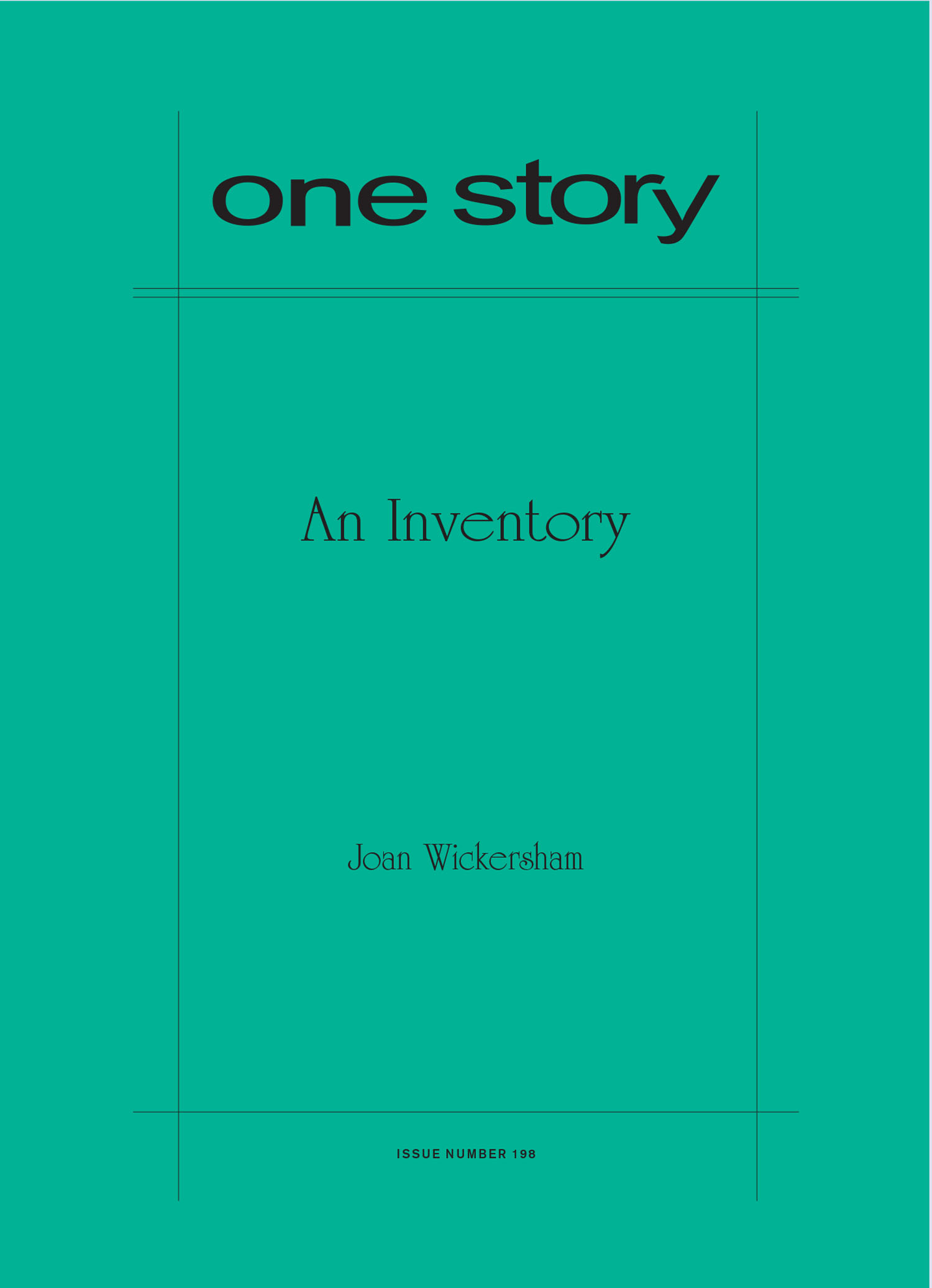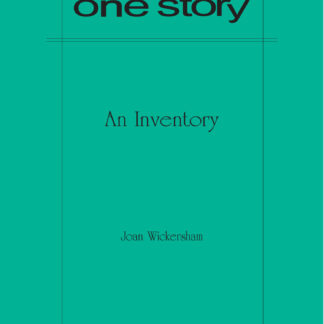
An Inventory
$2.50
32 in stock
Excerpt
Boy 1 was small and soft. He seemed breakable. Serious, soft brown eyes. He built careful buildings in the block corner – this was in kindergarten – a tower on one side and a tower on the other side, an arch in the middle. He didn’t say much. Over spring vacation, he went to visit his grandparents in Texas. You had heard that there were rattlesnakes in Texas, and you worried all week. You kept thinking of him walking around in Texas, his small, unguarded ankles.
Boy 2 rescued you on the playground. There was a kid who always showed up dressed like a cowboy, who one day climbed the ladder just behind you, put his lasso around your neck, and pushed you down the slide. Boy 2 ran over to see if you were hurt – you weren’t, just shocked by the sudden viciousness of it – and to shout at the other boy, “Leave her alone!” He stood over you while you loosened the rope and helped you pull the noose off over your head. After that day neither of them paid much attention to you, though you taunted the kid in the cowboy suit and looked behind you whenever you climbed the ladder to the slide.
Joan Wickersham
Joan Wickersham’s most recent book of fiction is The News from Spain: Seven Variations on a Love Story (Knopf). Her memoir The Suicide Index (Harcourt) was a National Book Award finalist. She is also the author of The Paper Anniversary (Viking). Her short fiction has appeared in The Best American Short Stories, The Best American Nonrequired Reading, and many other publications. Joan writes a regular op-ed column for The Boston Globe and her pieces have often run in The International Herald Tribune. She teaches in the MFA program at Bennington and has been awarded fellowships by the National Endowment for the Arts, the Massachusetts Cultural Council, the MacDowell Colony, and Yaddo.
Hannah Tinti on “An Inventory”
Whenever I’m feeling overwhelmed by life I make a list. Instantly I become calmer, as if by scratching out my ideas, tasks and responsibilities on paper, I’ve won half the battle. Our new issue, Joan’s Wickersham’s “An Inventory,” explores this same inclination for organization. In this charming story, a character (“you”) accounts for all of her romantic partners (even if that romance was one-sided), exploring the forces of attraction as well as the tender reaches of her own heart. Compiled chronologically, these brief anecdotes—with footnotes from the future!—become a marvelous meditation on love, faith and endurance. I was first introduced to Joan Wickersham while reading Best American Short Stories. Years later, working as a bookseller, I was thrilled to discover her wonderful novel The Paper Anniversary (and hand-sold many copies). Since then, I’ve kept track of her career and continued to admire her skillful carvings of emotional truth. Connections like this between a reader and a writer, that cover many years and many books, are why I got into the business of publishing, so it brings me particular joy to present “An Inventory” in our pages. I hope that all of you—our dear readers, writers, supporters and fans—will stop by our website to read Joan’s Q&A, and welcome her into the One Story family.
Q&A by Hannah Tinti
- HT: What was the seed of this story? What was the first thing you wrote?
- JW: One day a long time ago I was helping out at my son’s nursery school and he was on the swings next to a little girl. He was barely aware of her, talking in great detail about how he wanted to be an astronaut and go to the moon, and she was gazing at him and saying, “Can I go to the moon with you?” It made me think of all the boys I had adored beginning in kindergarten and wonder what all that adoration was about. Years later, I tried to write a story of a woman’s life through a series of vignettes, each focused on a boyfriend, but I gave up after a paragraph – it just felt dead on the page. And then four years after that, I found the paragraph again, liked the part about the block towers and the rattlesnakes, threw out the rest, and felt the whole thing wake up and start to move.
- HT: What was the most challenging aspect of writing this story?
- JW: Finding the right stance and the right voice. I didn’t want it to be breathless or earnest, a simple romantic history – that’s what was wrong with that first, abandoned attempt. But I also didn’t want the voice to become so cynically mocking that the strong feelings were lost.
- HT: Why did you choose to use the second person (“you”)?
- JW: I don’t know. It was an intuitive choice. But I think that having stumbled onto the “you” voice I kept it because it showed me that the narrator is looking back across the years and addressing her old self – it’s at once intimate and distant. I never really know what I’m doing until after a piece is finished; but now I see that the whole story is really about perspective and about time.
- HT: Did you know from the start that this story would be a catalog of sorts?
- JW: Yes. But the first time I tried to write it, that was all I knew, and it wasn’t enough to build a story on. It was a catalog, a list, but so what? Why? It felt like a conceit. But sometimes when something isn’t working the solution isn’t to drop it, it’s to go deeper into it and make it more emphatic. When I started the story the second time, I began with the idea of an inventory – a narrator who is tallying up and assessing, in this cool, numerical, deliberate, sociological way, her romantic and sexual history. I’ve always loved the catalog aria from Don Giovanni, which is a wild take on sexual bragging, with numbers in the thousands. Maybe this story is my inversion of that kind of list. The point isn’t sexual conquest; it’s an inventory of craving whatever that little girl on the swings was craving.
- HT: I love the asides that you use throughout “An Inventory.” In what stage of the process did you decide to use footnotes, and how do you think that affects/informs the reader’s experience of the story?
- JW: That was another happy accident. I wrote the bit about Boy 5’s mother dying and the narrator remembering her saying “Would you be an angel?”, but it interrupted the story’s momentum. I couldn’t decide whether to cut it or not, so I just stashed it at the bottom of the page. I moved on and then a little later I came to something else that jumped into the future and didn’t fit with the time sequence of the story, and I realized that I could use footnotes to layer time, and that the story could proceed simultaneously in an intensely emotional past and a more reflective present. I am always wishing, when something really tough or terrible happens, that my future self could somehow show up and tell me it’s going to be all right; and maybe that desire helped to fuel this story which is really all about desire. The reader gets to be both in step with and way ahead of the character.
- HT: There is a disconnect in each of her interactions with these boys—even in the most intimate moments. It’s heartening to see her keep trying to find love, despite this. Do you think that’s what this story is about, the search for a moment of true connection? Or is it about understanding when that connection hasn’t been made?
- JW: I think it’s about yearning, and not being sure if the thing you are craving really exists. The encounters do become more harsh as they go along. She’s afraid that she is starting to harden, and that maybe it’s her own romanticism that’s doing her in, maybe she wants too much. And again, it’s about perspective, and the perspective you can’t have about your own life when you’re in the middle of it. I think of that shot in The African Queen when Humphrey Bogart and Katharine Hepburn have gone as far as they can go, hauling their boat through the mud, and they lie down believing they’re going to die – and then the camera pulls back to show what they can’t see: open water just a few yards away. We know from the last footnote that a better ending is in store for this woman, but the story ends in a place where we’ve seen it and she hasn’t yet.
- HT: How long did it take you to complete this story?
- JW: Eleven days – but only after letting that first, failed, one-paragraph attempt sit around for four years.
- HT: What are you working on now?
- JW: After years of saying “I’m writing a book about my father’s suicide” and watching people recoil, and then some years of saying “I’m writing a book of stories that all have the same title but the title means something different in each story” and watching people look puzzled or bored, I’ve learned that I never know how to describe what I’m doing – it always sounds vague or stupid. But I am having a good time doing it.
- HT: What is the best bit of advice about writing you have ever received?
- JW: There are two. The first came from my husband, who is a wonderful reader and editor. Years ago I showed him something I’d written, and in trying to explain what he didn’t like about it he said, “You need to write the way you talk.” He meant, Don’t be fancy, don’t try to imitate what you think a story is supposed to sound like. The other also came years ago, from a good friend. I was having huge doubts about myself as a writer, everything was so slow and nothing ever came out on the page quite the way I’d wanted it to, and I said to him, “It shouldn’t be this hard. Maybe it’s hard because I stink.” And he said, “No, it’s hard because it’s hard.”
